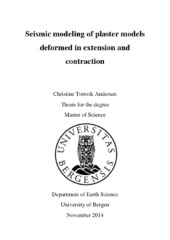Seismic modeling of plaster models deformed in extension and contraction
Master thesis
Permanent lenke
https://hdl.handle.net/1956/9183Utgivelsesdato
2014-11-18Metadata
Vis full innførselSamlinger
- Department of Earth Science [1103]
Sammendrag
The effects of overburden, burial depth, source-receiver distance and frequency on seismic resolution have been studied in this thesis. Synthetic seismic sections of two plaster models, where a volume of plaster has been deformed in a plane strain deformation apparatus, have been created using the NORSAR- 2D/3D- and SeisRoX modeling tools in order to observe which properties that enhance the seismic images in the best possible way. Three different models have been created for each plaster model, hence, six different models will be displayed in this thesis. The modeling experiments differ with regards to velocity and density based on burial depth, where one shallow, one medium and one deep model have been created. The plaster models were photographed and transferred into the NORSAR-2D software in order to create a geophysical framework for synthetic seismic modeling. Based on well logs provided by Statoil ASA (Appendix A), four different stratigraphic units were used as an analogue in order to establish the P- and S- wave seismic velocities and densities, and calculations of the matrix shear- and bulk modulus were made. Each artificial layer in the plaster model was assigned with values from each stratigraphic unit, in order to create a realistic model. It has become clear that the distance between source and receiver is crucial when it comes to representation of dipping reflectors. Also, I demonstrate that regardless of survey direction, the same structures were displayed in the seismograms of similar depth, except for additional noise and lower reflection amplitudes in the strike survey seismograms. When it comes to resolution of subsurface structures and potential reservoirs, creating synthetic seismograms based on structurally realistic plaster models can possibly relate the synthetic seismic sections to real seismic data, which is shown in this thesis.
